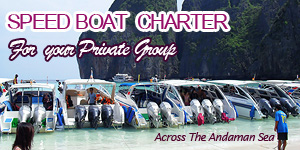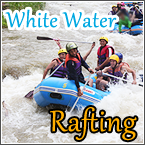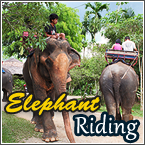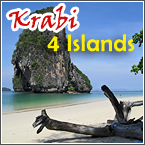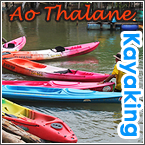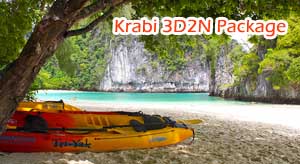Krabi Early History
June 26, 2009 by admin
Filed under Attractions
Krabi is one of Thailand’s oldest historical sites with evidence reflecting to this day, what it once had been.
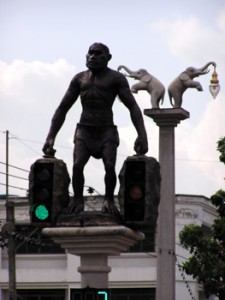 27,000 – 37,000 years ago the primate ancestors of prehistoric man inhabited the area. Their remains are believed to have been discovered by archaeologists in Nuerklong’s lignite mine.
27,000 – 37,000 years ago the primate ancestors of prehistoric man inhabited the area. Their remains are believed to have been discovered by archaeologists in Nuerklong’s lignite mine.
EARLY EVIDENCE
Scientific proof of the migration of primitive man and wall paintings in cave sites of Krabi and Phang Nga show that those sites had been settled in by prehistoric man. As for the early cave painting depicting symbolic image of land and marine creatures in black, red and brown, estimates of their age vary at between 3,000 and 5,000 years old.
LATER EVIDENCE
Other proof, – stone tools, earthenware, skeletons, beads, bronze tools, items of pottery, coins, metals, moulds and seals – collected from more than twenty local sites, show that what became a wild jungle was once the home of cave dwellers.
TRIBES
It is generally believed that the history of Krabi’s modern day settlers began with the merging of two tribes the Sagai or Semuang shack dwellers with the Orang Laut or Chon Chao Num wandering sea gypsies.
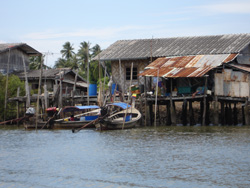 PROSPERITY
PROSPERITY
Krabi has very rich natural resources, coming from the streams, flowing down onto the valleys, along lowland plains and out into the coastline. It was the river estuary and coast land of Krabi, where the people settled, which brought early prosperity. It became a sort of treasure gateway for pioneering traders, a number of different races, which included Romans, Arabs and Indians. From a geographical point of view, it was inevitable that the land of Krabi should serve as a trading centre for the Malayan peninsular, offering shelter from the monsoon rains and winds, a natural harbour and a shipyard. Furthermore, it was to become a place where provisions for onward voyages could be prepared, and where stock from incoming traders could be collected and dispatched by the fortune hunters. (Read more on this aspect)
ACROSS THE PENINSULAR
According to records left to us by a Chinese monk in 381-414 AD, any voyage passing through the Malacca channel to the tip of the Malayan peninsular was threatened by the high risk posed by pirates. Moreover, the technical knowledge and development of ships of this period was not advanced enough to make a long sea journey secure. Instead, the navigators traded increasingly along the coastal piers before traveling across the peninsular. (Read more on this aspect)
COMMUNITY
One early settlement of people was on the banks of a canal known as Klong Tom, which flows from the mountain range along the border, where the two provinces of Krabi and Trang meet. Klong Tom itself is deep eough to allow ships to penetrate as far as 20 km inland. Klong Tom is also connected with many other water courses, three of which lead to the sea on the East coast in the province of Surat Thani. Monsoon historians claim that Klong Tom was the most suitable direction for ships to head to in the monsoon period. Most ships on their return to India would have needed to change course to the West, but the monsoon caused ships to change their route to between 7 and 8 degrees latitude, in the area of Trang, Klong Tom and Phang Nga.
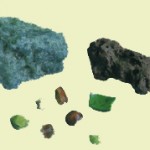 PIER AND MARKET
PIER AND MARKET
Ancient Klong Tom or Kuan Luk Pad was probably the earliest pier of a community supplying herbs, aloes, wood, and black peppers, amongst other products for foreign traders from different western countries. Proof from archaeological findings – Roman or Egyptian coins, beads showing human faces, art, a piece of Roman earthenware, and the largest production site of beads on the peninsular confirm beyond doubt that this area was a major international market place of those times.
LOST CIVILIZATION
With the discovery of an inscribed seal in Klong Tom dating back 2,000 years, the historians conclude that people had established settlements here several times before the beginning of history. What caused Klong Tom’s later impoverishment, however, remains a mystery. One theory is that Klong Tom fell to cholera, another is that it was attacked and defeated by Tamils.
INVASIONS
In 1024 – 1044 the Dravidian forces from India encroached on and occupied the Malayan peninsular. They used the islands of Phuket and Sriboya to base their navy and attempt to conquer the sea on the West coast. The Tamils were later annihilated by Prachao Jantharapanu. Krabi was first governed by Nakorn Sri Thammarat. Like all the Asterism yowns, it used the symbol of the monkey for its official seal in the begining of the Rattanakosin period. Following a decree issued in Pagasai by the governor of Nakorn Sri Thammarat called Chao Praya Nakorn (Noy), people arrived from Nakorn Sri Thammarat to settle in Krabi.
ELEPHANT TRADING
The export of elephants to India first took place in 1812, after the construction of huge boarding bridge for elephants. In 1872 during the reign of King Chulalongkorn, Pagasai was raised to town status, and renamed Krabi, apparently after a sword or ‘krabi’ found nearby. Its first office was in Ban Hin Kwang. In 1875 Krabi became a major western borough, ruled by its first Vicery, Luang Thep. Popular records tell us of a number of elephants being caught by 1949. In 1954 the villagers at Ban Nongjude in the district of Lum Thab presented a white albino elephant named Prasavet Adunlaya Detpanon to the current King of Thailand.
MINING
In 1900 coal was excavated and used as fuel instead of wood. This continued until 1917 when World War I broke out, causing the coal mine to go bankrupt. From 1964 Krabi’s electricity was supplied by the lignite mine in Ban Nuerklong. Other mines were opened in 1978 at the sites of Ban Klong Wai Lek and Klong Mark.
CAVE PAINTING LEGACY
PEE HUA THO CAVE
The cave comes from the Carboniferous to Permian period, 230 – 340 millions years ago. There are paintings in the cave, which are believed to belong to the early prehistoric tribe of wandering sea gypsies called Chon Chao Num. They seem to perform the function of a picture story, possibly to record the tales of ancestors or possibly to play a role in religious ceremonies. All we are certain of, is that the wall paintngs provided communication between groups of people. Pee Hua Toh cave also contains stalactites, stalagmites, tubular stones and skulls – the largest of which the cave owes its name to (Pee Hua Toh actually means “big headed ghost”).
VIKING CAVE (PAYANAK CAVE)
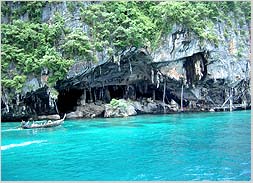 This is to be found on Phi Phi Island, Krabi. The sailors or pirates, who spent time in this cave, and left behind wall paintings, were possibly sheltering from monsoon storms. Perhaps they needed to proclaim their extraordinary escape from danger on this splended island, by representing their boats in a series of mysterious pictures.
This is to be found on Phi Phi Island, Krabi. The sailors or pirates, who spent time in this cave, and left behind wall paintings, were possibly sheltering from monsoon storms. Perhaps they needed to proclaim their extraordinary escape from danger on this splended island, by representing their boats in a series of mysterious pictures.
KHAO KHIAN NAI SA
This cave, once lived in by a prehistoric sea-faring people, illustrates for us how such people moved from one place to another in the area between Phang Nga and Krabi.
LAEM FAI MAI
Man-made carvings, cut into the limestone cliff some 3,000 to 5,000 years ago, show colored paintings depicting people and their animals. Most imply that the people lived near the water’s edge. Below the carvings is a layer of shells and barnacles, showing the changed sea level of previous times.
KHAO GAROS
This is a limestone mountain surrounded by a beautiful expanse of untouched mangrove, several kilometres wide. Next to a picture of people with animals, some round dots and thick lines of unknown meaning are also found on the wall, most of them red in colour. Khao Garos’ paintings are believed to be prehistoric and related to all the other cave paintings in the area.
CHAO LEY CAVE
The paintings are carved on two mountains, one in Chao Le itself and the other at the tip of the cape. They depict a man riding on the back of a creature, possibly a horse.
KHAO TEEB NUI
The site shows a rough painting with some barely recognizble objects. A variety of artifacts found here imply this was once an ancient treasure trove. It is a recently found site and research has yet to commence here. Nevertheless, it may be from the same period as Pee Hua Toh Cave.
LAEM KOH YOR CAVE
Adjacent to Khao Teeb Nui and Pee Hua Toh Cave, this cave contains densely coloured paintings of a man with a crab-like creature, as well as the remains of ancient pottery.
TOH LUANG CAVE
This site is to be found in the limestone mountain on the fertile plain of palm oil and rubber plantations. the many archaeological finds here include the remains of human bones, horns and pottery.
SUER CAVE
This is a located in a group of limestone mountains, where a great number of caves and grottos can be found. The grottos at the front mark the development of two periods, prehistoric and post-historic cave dwellings. Many treasures, e.g. important relics, amulets and items of pottery have been collected here.
POENG HIN NA CHING
This is in the same mountain range as Suer Cave. Also of prehistoric dating, archaeologists here diecovered the remains of a three-legged pot, a scrubbed stone axe, a carving tool and skeletons of both humans and animals.
TAAB PRIK SCHOOL CAVE
This archaeological site is an established centre of prehistoric study. Artifacts found here date back to the liocene period, which was when the ancestors of man migrated south for the first time, from South East Asia to New Guinea and Australia. This research centre is noteworthy for being known site in Thailand and South East Asia. Of many items of prehistoric evidence, there are tombs and skeletons, many pieces of pottery, tools made of stone and horn, bones, shells and seeds.
SUER NOK (THEPNIMIT CAVE)
Millions of shells attached to the outer limestone cliff side and inside the cave were caused by sea water passing through the tunnel beneath one cave leading to the larger Mue Cave. On one side is Orahan Cave, with dazzling tubular crystals of stalactites and stalagmites. The cave also houses a Buddha image, ornaments, skeletons and some remains of pottery.
SUER NOI CAVE
This cave was formely in a fertile area with wild animals and a surrounding forest. The discovery of a footed tray with round and conical shapes, sandstone, and akeletons, lead archaeologists to believe that the Suer Noi Cave has historical connections with the Pee Hua Toh Cave paintings.
KLONG TOM MUSEUM
The museum located in Klong Tom, of Tambon Klong Tom Tai, contains tools from both the Stone Age and the Bronze Age : metal coins, fragments of ceremic decorative art and 5,000 year old colored beads. These were excavated from Kuan Luk Pad behind the temple.
Source : Krabi Tourism Association






